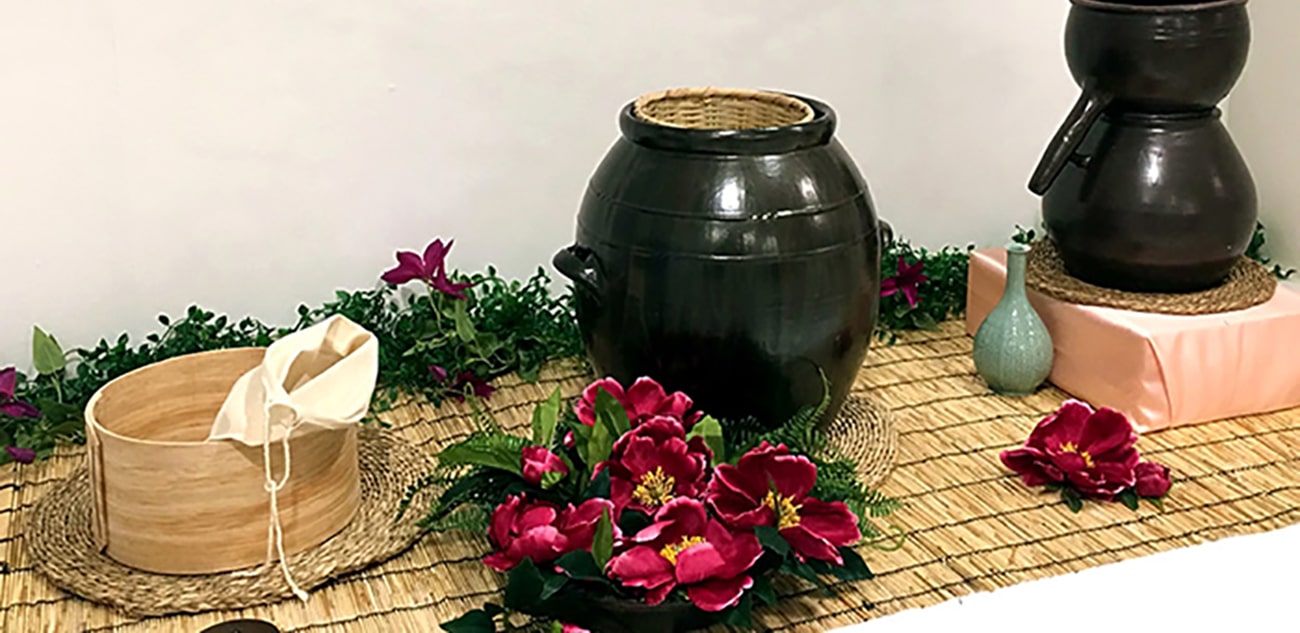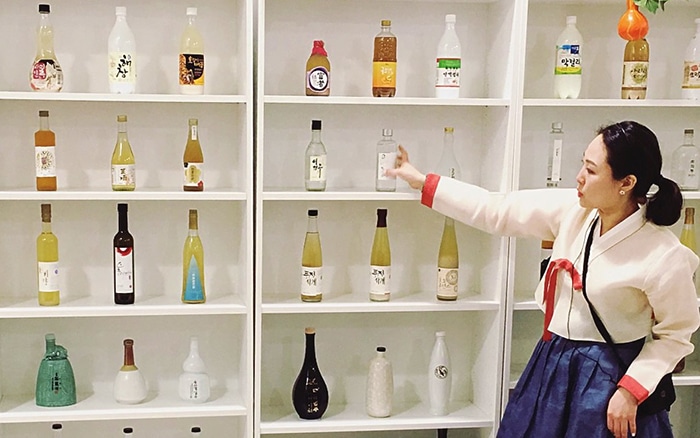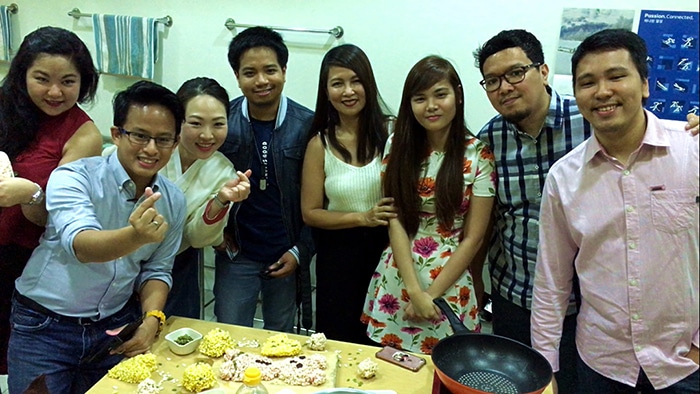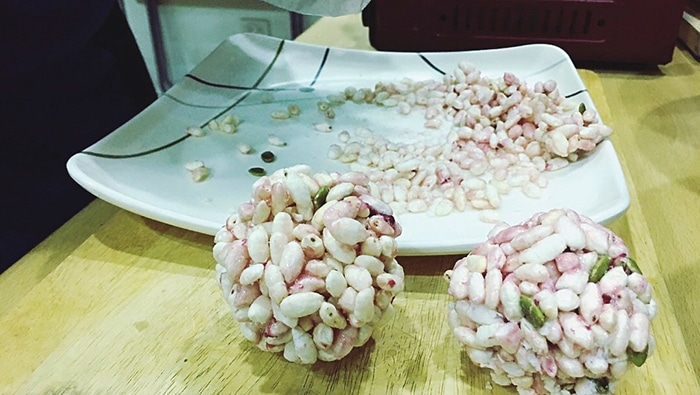
Korean drinking through traditional liquors
By Korea.net Honorary Reporter John Paul Vergonia from the Philippines
Photos = John Paul Vergonia

Chun Jisung shows an audience some of the most delicate, traditional and modern liquors available in Korea today, from common rice wines, fruits and flower-infused liquors through to the most expensive brewed styles of Korean sul clear alcohol.

In olden days, there was no particular method to make traditional liquor, as there were so many ways that were passed down by families through the generations. As was emphasized during the tour guide’s talk, you can actually make different kinds of liquor from just one brew, like makgeolli, which can be made into takju, and when it is refined and distilled it becomes yakju and soju, respectively.
Makgeolli rice beer is labelled as a milky and sweet alcoholic drink. It is Korea’s most representative and oldest traditional liquor that is commercially available today in a plastic bottle. It has a low alcoholic content of about 6 to 7 percent. It’s naturally fermented and unfiltered, which gives its color a milkish and off-white tinge. Makgeolli is typically served in a small bowl instead of a cup. Being brewed since the Three Kingdoms of Korea (57 B.C.-A.D. 668), the milky liquor is not solely enjoyed as takju. Although it resembles it, in the category of unrefined rice wine, like makgeolli, takju has more alcohol at around 10 percent. As Chun said, you can distinguish the two alcoholic drinks from an unrefined brew of rice liquor by the chalky sediment that clears up and stays at the bottom. You can see a much clearer form of the alcohol in takju but once you shake the mixture, it makes the cloudy and sweet rice liquor makgeolli.
On the other hand, the naturally fermented rice wine takju can also be turned into yakju, a refined alcohol that’s clearer and that doesn’t have any sediment, at about 14 to 20 percent alcohol. Yakju is considered to be a premium brew that’s usually infused with bark, flowers or medicinal herbs, and is offered normally only on special occasions and during ancestral rites. The same goes with the distilled version of the alcohol well-known as soju that’s commonly bottled in little green glass bottles. With its 40 to 70 percent alcohol, it’s the modern take on traditional rice liquor and is popular as shots.
These are just a few of the thousands of alcoholic drinks found across the vast world of Korean cuisine. Most of them are made from fermenting rice and other grains with the nuruk base. Other than the varieties of traditional and modern alcohols that are put on display in the exhibition, the exhibition also gave audiences the opportunity to appreciate more of what Korean liquor is all about, and also the alcohol drinking traditions of ancient Korea, that are all about tradition, lifestyle and social organization and social ranking.
Drinking etiquette is also an important aspect to Korea’s food and drinking habits, and plays a significant part in the traditions of old Korea, particularly during Joseon times (1392-1910). When it comes to manners and drinking alcohol, people abide by strict rules that are still exercised today, although they have progressively changed over the years. As seen in various period soap operas, drinking etiquette involves pouring and receiving drinks.
It is traditional that when receiving drinks from someone older than you, the younger person will receive it with two hands and take the drink in a polite manner by bowing the head slightly with appreciation. The younger drinker then must turn away from the older friend, covering both the mouth and the glass with the two hands when it’s time for them to drink, as a sign of respect, and must take it all in one shot. The same etiquette is observed when pouring a drink for a friend who’s older than you. You have to offer the alcohol in a respectful manner and the younger friend must use both hands to offer the empty glass to the older friend who poured their drink, and then pour a shot for them.


Along with Chun Jisung, participants pose for a photo after making and trying out their own version of traditional confections.
Korean drinking habits and its long history of alcohol-related traditions are just as inviting as its global cuisine, as traditions surrounding the consumption of alcohol were also influenced by the country’s long and enduring history, and it, too, just like the cuisine, continues to earn praises from around the globe. Little did we know that the normal kinds of Korean food that we have learned to love also have their own matching traditional drinks that enhance not just the taste and flavor but also the culinary experience as a whole.
The Korean Cultural Center in the Philippines hosted yet another first-of-its-kind in the country. Its first exhibit set this year was “Korean Sul”. Korea has a promising tradition of consuming alcohol and a long history of drinking that is already being shared and is ready to be appreciated by many people today. The exhibit was curated by Korean liquor sommelier Chun Jisung. It required one year of preparation to finally bring it to the Philippines. The exhibition is everything about her sharing her passion for Korean alcohol and inspiring the audience, from its great history to understanding preparation methods and brewing processes, as well as the variety of traditional and modern Korean alcoholic drinks, all the way until they’re served on the table complemented with a set of good food. She also talked about the associated drinking patterns that are distinct to Korea.
Sul or sul (술) simply translates as “alcohol”. It’s mostly made from grains, with rice being the most common one. They undergo a brewing process with the help of the traditional fermentation starter, called nuruk (누룩), which is packed with wheat-based enzymes used to break down the rice starch into sugar along with yeast that converts into alcohol.
Korean alcohol has various types, such as the milky ones like makgeolli (막걸리) and takju (탁주), clear rice wines like yakju (약주), modern distilled liquors like the way-too-popular soju (소주), and the flavored options that are made from fruits or infused with flower essences and medicinal herbs to give the alcoholic beverage a unique taste.

A juansang (주안상) table setting is on display to showcase foods that are complementary with traditional liquors.

Hangwa snacks are a traditional form of confection that go well with Korean liquors.
While it’s all about showing appreciation or respect, with regard to food, they are also complemented with alcoholic drinks. Commonly termed as anju (안주), these foods are normally served along with alcohol, like samgyeopsalgrilled pork belly and all kinds of appetizers that go well if paired with soju, makgeolli and its complementary food bindaetteok mung bean savory pancakes and other pan-fried jeon savory pancakes, the royal dish gujeolpan platter of nine delicacies that’s best paired with wangju, as well as traditional snacks, biscuits and rice cakes that are suited with fruit and medicinal wines. In the exhibit, there was an area that showcases sets of food and drink pairings and few of them were set up on a table setting called a juansang (주안상). It’s a traditional table setting designed to serve alcoholic drinks paired with snacks, appetizers and other foods that were mostly enjoyed by the royalty and upper classes in earlier times.
To better understand and experience first-hand some of the most popular Korean alcoholic brews available today, exhibit attendees were introduced to six liquors that are combinations of traditional and modern brews. This includes the silky yet sweet makgeolli, fruit flavored makgeolli, a medicinal liquor instilled with ginseng and apple-flavored soju.
Some people also tried to make their own brews of homemade makgeolli to show their deep appreciation of Korean sul and to learn how to brew traditional rice wine from scratch, where one can observe how it will turn into an alcoholic drink in two weeks. Participants also got to try making a light yet sweet accompaniment called yeot gangjeong (엿강정), candied rice puffs with dried fruit and toasted seeds that’s a variety of hangwa (한과) or traditional confections for a simple juansang table setting.
With the continual fame of Korean cuisine today, it’s for sure that traditional Korean liquor will soon follow its popularity, such as that of the success that the green bottles of soju are gaining, which continues to sit on the shelves of many Korean restaurants and Asian stores across the globe. Although commercially made soju is processed and modern, it’s still part of the drinking habits in Korea where many find a shot of the distilled spirit an enjoyable boost to keep and make new friendships.
Through better understanding of Korean drinking habits, then and now, and with such exhibits to further promote Korean sul as a tradition, it’s not just a knowledge to enrich but an awareness of this important aspect that made and contributed a lot to the rich heritage and traditions of Korea today. Moreover, to be more appreciative of such drinking traditions and to enjoy the very best that traditional Korean alcohol has to offer, it’s great to get started soon. Cheers!
wisdom117@korea.kr
* This article is written by a Korea.net Honorary Reporter.
Our group of Honorary Reporters are from all around the world, and they share with Korea.net their love and passion for all things Korean.
Read more: http://www.korea.net/NewsFocus/HonoraryReporters/view?articleId=160992

